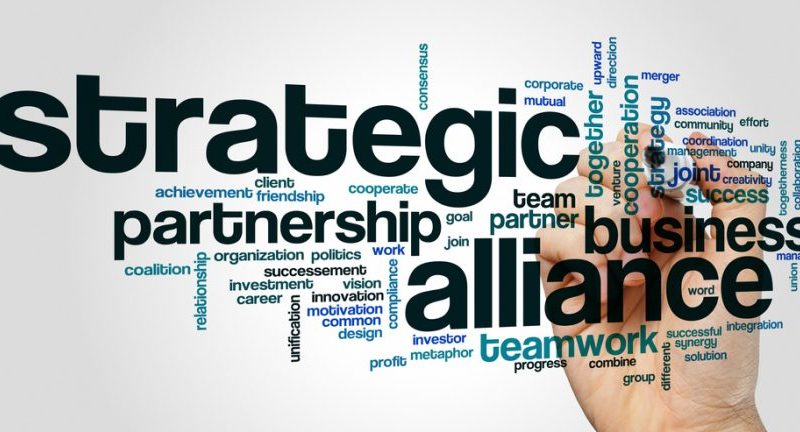Alliances and partnerships are important components of business strategies for both large and small firms. However, while many alliances begin with lofty goals and ambitions, not all of them turn out to be strategic. In the last few months, I’ve seen examples of new strategic alliance formed among the world’s top corporations. But, what exactly is a strategic alliance, what are the different types of strategic alliances, and how can they benefit — or harm — your company. Oh well, you heard me right, it does begin with the intention of benefitting companies but in the long run, it may harm your company. Also, why do we require them for success in today’s marketplace? Let’s start.
What Exactly Are Strategic Alliances?
Strategic alliances are agreements between two or more separate companies to collaborate in the manufacturing, development, or sale of products and services, as well as other corporate goals. In a strategic alliance, for example, Company A and Company B pool their resources, capabilities, and core competencies to generate mutual interests in designing, manufacturing, or distributing goods or services. Let’s see the types of strategic alliances we have in the next section.
Types of Strategic Alliance
There are three types of Strategic alliance: joint ventures, equity strategic alliances, and non-equity strategic alliances.
#1. Joint Venture
The first type of strategic alliance is a joint venture. This is when the parent companies form a new child company, they form a joint venture. Company A and Company B (parent firms) can, for example, form a joint venture by forming Company C. (child company).
Furthermore, if Firm A and Company B each control 50% of the child company, we refer to it as a 50-50 Joint Venture. The joint venture is categorized as a Majority-owned Venture if Company A owns 70% and Company B owns 30%.
#2. Strategic Equity Alliance
In this type of strategic alliance, one firm buys a particular amount of the other business’s equity, forming an equity strategic alliance. An equity strategic alliance would be created if Company A purchased 40% of the equity in Company B.
#3. Non-equity Strategic Alliance
A non-equity strategic alliance is a type of alliance formed when two or more organizations enter into a contractual agreement to combine their resources and talents.
Having seen the different types of strategic alliances, let’s see the benefits and possible challenges.
The Benefits of Strategic Alliances
Consider three different product life cycles to better understand the motivations for strategic alliances: Slow cycle, Standard cycle, and Fast cycle. The necessity to develop and continuously generate new items in an industry determines the product life cycle. The pharmaceutical business, for example, has a slow product lifecycle, whereas the software business has a fast product lifecycle. The motives for strategic alliances change for organizations whose products are in a distinct product lifecycle:
#1. Slow Cycle
A company’s competitive advantages are protected for comparatively long periods throughout a sluggish cycle. The pharmaceutical sector has a delayed product life cycle because products are not developed every year and patents are granted for a long period.
Strategic alliances are created to get access to a restricted market, maintain market stability (by establishing product standards), and build a franchise in a new market.
#2. Typical Cycle
In a typical cycle, the company produces a new product every few years and may or may not be able to maintain its industry leadership position.
Strategic alliances are created to gain market share, push out competitors, combine resources for significant capital projects, achieve economies of scale, or get access to complementary resources.
#3. Quick Cycle
The company’s competitive advantages are not protected in a quick cycle, and companies operating in a fast product lifecycle must constantly produce new products/services to survive.
They are formed to accelerate the development of new products or services, share R&D costs, simplify market penetration, and combat uncertainties.
Strategic Alliance Value Creation
Strategic alliances add value by doing the following:
- Enhancing current operations
- Changing the competitive landscape
- Ease of access and exit
- Current activities have been enhanced as a result of:
- Scale economies resulting from effective strategic alliances
- The ability to learn from one’s coworker(s)
- Partners share the costs and the risks
2. Changing the competitive environment by implementing:
- Developing technological standards (for example, Sony and Panasonic announce to work together to produce a new-generation TV). This would contribute to the establishment of a new norm in a competitive context.
3. Facilitating company entry and exit through:
- Entry into new industries at a minimal cost (a company can form a strategic partnership to easily enter into a new industry).
- A low-cost way out of industries (A new entrant can form a strategic alliance with a company already in the industry and slowly take over that company, allowing the company that is already in the industry to exit).
Advantages Of Strategic Alliance
- It is flexible to operate
- There is no need to merge capital or pull resources together
- It allows for independent
Advantages Of Strategic Alliance
- It may lead to one company being dependent on the other as time goes on.
- A conflict interruption may greatly affect one of the two companies.
Challenges of Strategic Alliances
Although strategic alliances add value, there are several issues to consider:
- Partners may exaggerate what they bring to the table (lie about competencies that they do not have).
- Partners may fail to commit resources and skills to one another.
- One party may make a significant investment in the alliance while the other does not.
- Partners may fail to make full use of their complementary resources.
Now let’s go over some strategic alliance examples.
Successful Strategic Alliance Examples
Just because two things don’t appear to go together at first glance doesn’t imply they aren’t a good match. Some organizations may appear to have little in common at first glance, but a closer study may reveal some similarities—customer bases with similar interests, the capacity to leverage one client pool with another, or even a symbiotic collaboration that has been going on for years.
The organizations participating in most strategic alliances have the potential to reach further afield within a possible client pool. And with two sales teams in the channel, you have access to twice as many prospects as if you were working alone. Not to mention co-branded marketing content.
The following are five examples of strategic alliances that paid off handsomely.
#1. Eddie Bauer and Ford
You may recall the Eddie Bauer edition of the Ford Explorer. Premium leather seats and other luxurious elements are available throughout the car. Eddie Bauer was making luggage sets with Ford branding on them at the time, in addition to the car itself. These co-branded items served as excellent promotion opportunities for both companies.
The vehicle’s key selling point was that it fit a previously occupied segment by foreign automakers: the premium SUV market. Customers asking for a finely furnished sports utility vehicle made on American soil were satisfied when Ford collaborated with Eddie Bauer.
#2. Uber and Spotify
To bring us up to date, Spotify and Uber have partnered to provide stereo control to Uber customers. Not every Spotify user rides in Uber, and not every Uber rider has a Spotify account. The strategic alliance enables each company to pursue prospects from the other’s existing customer base while still promoting both products.
In both cases, it gives the company a competitive advantage. Spotify’s Premium package includes something that other streaming services do not yet provide. Similarly, Uber may allow riders to listen to their playlists, which rival ride-share services cannot currently match.
#3. Luxottica and Google
While you might not conceive of them working together, the collaboration was just what each company needed to push forward in the industry.
Luxottica can deliver premium quality eyeglasses to the luxury market, justifying the price with the fact that technology is driving the price, while also maintaining and increasing its market share by widening its customer base. Google, on the other hand, can deliver technology with a touch of elegance and attract people who, regardless of technology, may be looking for glasses with a premium aesthetic.
#4. Disney and Hewlett-Packard
This collaboration was formed when Mr. Hewlett, Mr. Packard, and Mr. Disney were still active in their separate businesses. Disney purchased audio equipment from Hewlett-Packard for the production of Fantasia. The strategic partnership was maintained since Disney relied significantly on HP’s development and IT teams for its infrastructure.
In reality, the Imagineering team at current-day Disney attractions is still very much tied to the HP systems design. During the design and construction phases of Disney’s Mission: SPACE, HP engineers and Disney Imagineers collaborated to create the most technologically advanced ride yet.
#5. Starbucks and Barnes & Noble
This is a matchup that has withstood the test of time. While many brick-and-mortar bookstores have closed owing to a lack of customers, the handful that has forged strategic connections have thrived. Barnes & Noble collaborating with Starbucks is one example of a long-standing strategic alliance.
Starbucks has been synonymous with coffee throughout the years. Whether you like it or not, you recognize the name. Customers have two reasons to shop at Barnes & Noble, with a Starbucks location in most (if not all) of them. All at one stop, take a coffee break and peruse the latest bestsellers shelf.
While we do not claim that this strategic cooperation has kept Barnes & Noble open, it is worth noting that several of its big competitors have since gone out of business. To continue in business in an era where digital media sales are continually on the rise, providers of printed material must be astute. Barnes and Noble have made an effort to keep ahead of the competition.
It is worth noting that the organizations that created these strategic alliances had little in common previous to their collaboration in all five situations. The consumer base may be the one point of commonality, albeit an indirect one in most cases.
Examples of Strategic Alliances That Failed
Not all collaborations are equal. Some collaborations are to fail from the start. And some only need a little tinkering to get both sides on the right track. Entering into a harmful—or worse—alliance can have a significant impact on a company’s success.
Let’s look at some examples to see why strategic alliances fail and how you can prevent them from happening in the future.
#1. Time Warner and AOL
Back when the “dot-com boom” was still a thing, AOL and Time Warner merged their operations in what is widely regarded as the worst merger of all time. On paper, the merger made sense: Time Warner would profit from AOL’s once-enviable online presence, while AOL would gain from Time Warner’s cable network and programming.
Needless to say, this was not the case. Spoiler alert: the dot-com bubble burst just months after the deal, and the entire economy became a slump. As you may recall, AOL’s business spiraled out of control, resulting in a $99 billion goodwill write-off in 2002 and a nearly $206 billion stock devaluation. Oh, no.
So, what is the main point here? According to a Fortune article, the ephemeral advantage is a phenomenon in which an organization’s initial capabilities degrade. They are replaced by a subsequent form of competitive advantage. AOL was heavily reliant on the promise of broadband (which, at the time, only 3 percent of the country had). The catastrophic merger was essentially unavoidable because its basis was on monthly payments.
Furthermore, the merger was doomed to fail from the start due to cultural incompatibilities. On the one hand, juxtaposed to Time Warner’s corporate, conservative culture, AOL represented an aggressive identity. Not only is it critical to understand the market, but it is also critical to ensure that your business’s product offers and cultures are complementary. Ascertain that both companies are on the same page and that everyone is working together to achieve mutual goals.
#2. Motorola and Cisco
Motorola and Cisco launched Spectrapoint Wireless, a joint venture, in 1999. They invested $300 million to acquire another telecom company’s fixed wireless assets and agreed to spend $1 billion to become the leaders in fixed wireless services. However, the relationship was dissolved after only one year. Why is this so? Because there were no customers to sell to.
So, what exactly went wrong with this strategic alliance? To begin with, the corporations were blinded by ambition—and believed in a sector that never truly took off. It’s easy to fall in love with the concept of adding value. However, it is critical to keep the alliance’s possibilities in mind at all times.
True strategic alliances are in response to a common challenge. Some alliances give firms access to new skills or capabilities. Partners, for example, may provide each other with a product that complements the other’s offerings. Other collaborations generate strategic advantages to boost competitiveness or access new markets. Regardless, it is critical to keep the eventual purpose of your alliance in mind at all times.
#3. Staples and OfficeMax
Staples attempted to buy up its competition, Office Depot, just last year—and failed spectacularly. While the $5.5 billion agreement seemed to promise a bright future for Staples, the merger fell through after antitrust concerns surfaced, and the Federal Trade Commission (FTC) denied the firms the option. According to the FTC, there is a chance that the cooperation may result in higher pricing and less competition.
Office Depot now owes Staples $250 million in breakup costs. What does this high-profile blunder represent? That is why, once again, it is critical to constantly assess the market and comprehend the impact your cooperation will inevitably have. Referring back to your intentions and objectives allows businesses to reroute a relationship that has veered off course and avoid forming one that is doomed to fail in the first place.
The value of strategic alliances and ecosystems is critical to an organization’s future success.
According to an Accenture poll, 76% of business leaders think that current company models will be unrecognizable in the next five years. The primary change agents will be ecosystems and strategic relationships.
True strategic alliances, on the other hand, require efficient administration to fulfill their full potential. This is more difficult than it sounds with the time and energy necessary for typical partnerships.
Corporations may tap into a practically endless marketplace of ideas, resources, and knowledge with strategic partners, which would be unthinkable in a solo effort while avoiding the obstacles that lead to unsuccessful partnerships and unrealized potential.
Why strategic alliance is important? alliances facilitate access to global markets. … However, through strategic alliances, companies can improve their competitive positioning, gain entry to new markets, supplement critical skills, and share the risk and cost of major development projects.
If Your Strategic Alliance Will Be Positive, It Must Meet Any of These Conditions
To be strategic, it must
- Reduces a big risk to the company.
- Crucial for the development or sustainability of a core competency or other competitive advantage.
- Prevents a competitor from gaining an advantage.
- A key component in achieving a major business aim or target.
- Develops or maintains the firm’s strategic choices.
If your strategic alliance will be successful or rather fruitful, you need to ensure your alliance is more strategic than conventional. The reason for this is simply that alliance is that the purpose of the alliance is more than the profitability that these companies look forward to.
How Crucial Are Strategic Alliances?
Through strategic alliances, a company can expand its audience without spending additional time or money. A franchise company is constantly looking for fresh, innovative approaches to grow its clientele and connect with new potential customers; establishing a strategic alliance offers one such chance.
Why Do Strategic Alliances Exist?
In contrast, the resource dependence theory argues that firms seek out strategic alliances to gain access to valuable resources that they do not have on their own. Organizational knowledge and learning also put a focus on why businesses want to learn or acquire the organizational knowledge of others.
How Do Strategic Partnerships Function?
Strategic alliances are agreements between two or more companies to collaborate on projects while keeping their independent identities. You can pool resources, use your combined expertise, and work together to achieve more than you could individually through this kind of partnership.
What Dangers Do Strategic Alliances Pose?
Many collaborations may result in a clash of corporate cultures or a feeling of diminished independence. Additionally, the partners can miss out on future commercial prospects with their strategic partner’s competitors.
What Does a Strategic Alliance Entail?
The scope of a strategic alliance may change depending on the work that the partners perform. Strategic alliances are possible in which partners participate in all commercial activities. In contrast, there are instances where partners handle the specific facets of the company, such as marketing, finance, R&D, etc.
Conclusion
The strategic alliance has over time placed businesses in better positions. But hey there is a catch, ensure you carefully analyze the future outcome of your alliance before forming one. Remember, if it must be effective, it must be strategic not conventional.
Strategic Alliance FAQs
Why strategic alliance is important?
Alliances facilitate access to global markets. … However, through strategic alliances, companies can improve their competitive positioning, gain entry to new markets, supplement critical skills, and share the risk and cost of major development projects.
What are the different types of strategic alliances?
Three Different Types of Strategic Alliances
- Joint Venture. A joint venture is a child company of two-parent companies. …
- Equity Strategic Alliance. …
- Non–Equity Strategic Alliance.
How do you create a strategic alliance?
1: Identify Potential Partners. …
2: Research Potential Partners. …
3: Make the First Call. …
4: The First Meeting. …
5: Identify Specific Opportunities. …
6: Establish Revenue/Profit Goals. …
7: Develop an Agenda. …
8: Present the Plan.
What is the difference between a strategic alliance and an acquisition?
Both acquisitions and alliances are often used strategies for external growth. Where an acquisition involves taking control over another company through obtaining shares or properties, an alliance comprises companies that cooperate to pursue shared goals while remaining legally independent
- Strategic Goals: Setting Goals For any Business(+ Detailed Guide).
- Strategic Risk Management: Overview, Plans, Implementation (+ Free tips)
- What Is Strategic Financial Management?- Functions and Importance
- Types of Marketing Strategies: 20+ that Work for any Business
- Chief Strategy Officer: Organization Chart, Job Description & Salary






